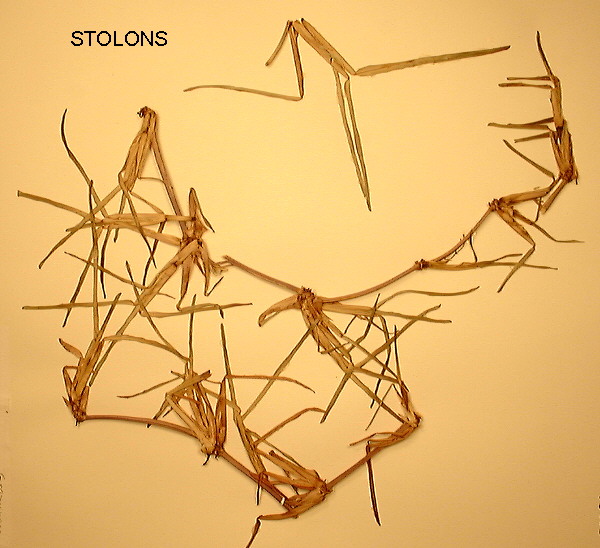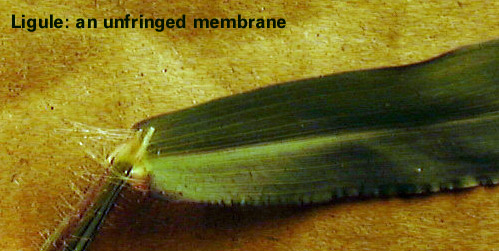Grass Systematics
Morphology
All grasses have fibrous secondary roots (the primary root disappears
early in development) and can be annual or perennial in which case they
usually have underground stems called rhizomes. These can be very
short and knotty or very long. In some species the rhizomes can go
for several meters. Sometimes these stems run horizontally above
ground and are then called stolons. Grasses characteristically have
stems that are round and usually hollow with a node (the swollen areas
along the stem where the leaves and branches are attached) and internode
(the part of the stem between the nodes) arrangement. Their leaves
are attached at the nodes and consist of two parts, the sheath clasps the
stem (also known as the culm) sometimes all the way up to or beyond the
next node. The blade is the upper part of the leaf that is free from
the stem. The fact that the top edges of the sheath may overlap each
other around the stem but are not joined to each other, is a defining characteristic
of grasses. At the point where the blade joins the sheath, there
may be a flap of tissue called a ligule. This structure keeps dirt and
parasites from getting into the space between the sheath and the stem.
The tiny grass flower, called a spikelet, is actually a composite of one
or more tiny flowers and is the most characteristic structure among grasses.
It is generally composed of two bracts called glumes with one to many tiny
flowers called florets attached above them. Each floret consists
of a bract called a lemma that generally wraps around a smaller and generally
very thin bract called a palea. These two encase the nearly microscopic
rudimentary petals called lodicules, the stamens (usually 1-3) and the
ovary which can have 2 or 3 feathery stigmas at its apex. There may
be only a few spikelets on a plant but usually there are many (sometimes
hundreds) arranged variously in an inflorescence. The inflorescence
is the plume-like structure that you see on sugar cane or the spike of
a wheat plant. Corn is a special case, both the cob and the tassel
are inflorescences but the cob has only female flowers and the tassel only
male. Some other grasses have separate male and female inflorescences
and many have some of the spikelets with only male flowers while other
spikelets in the same inflorescence have hermaphrodite flowers. The
grasses also have a very characteristic fruit (grain) called a caryopsis
which consists of the ovary with one or more of the floret bracts attached.
Vegetative Characters





